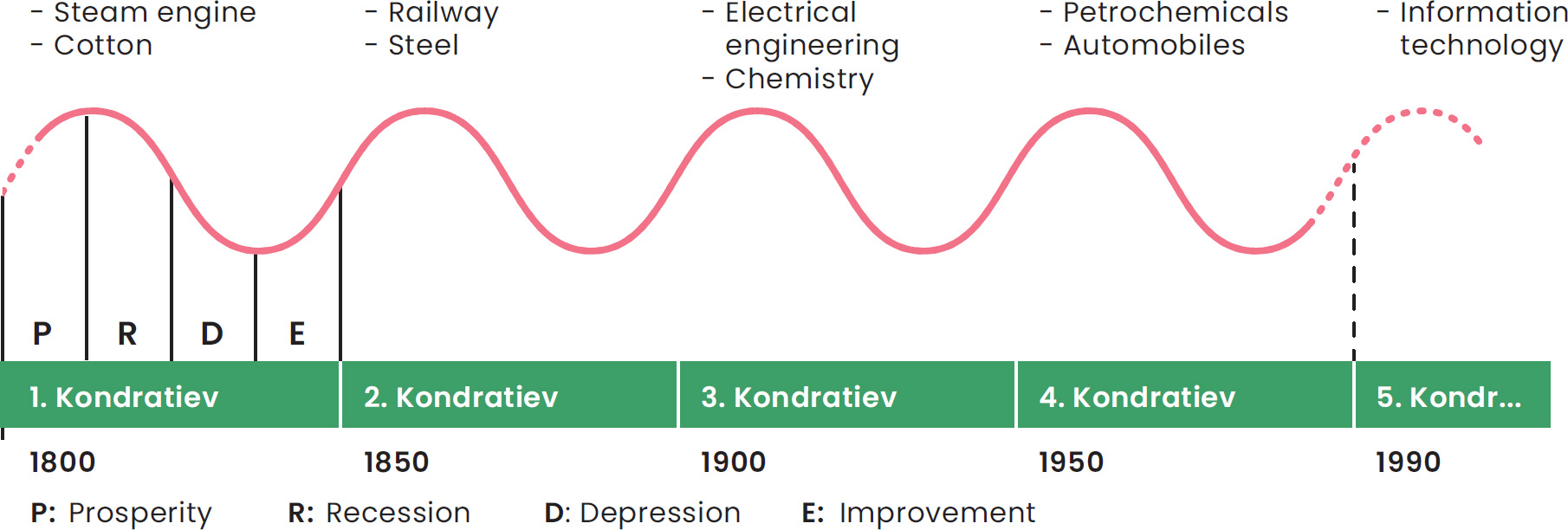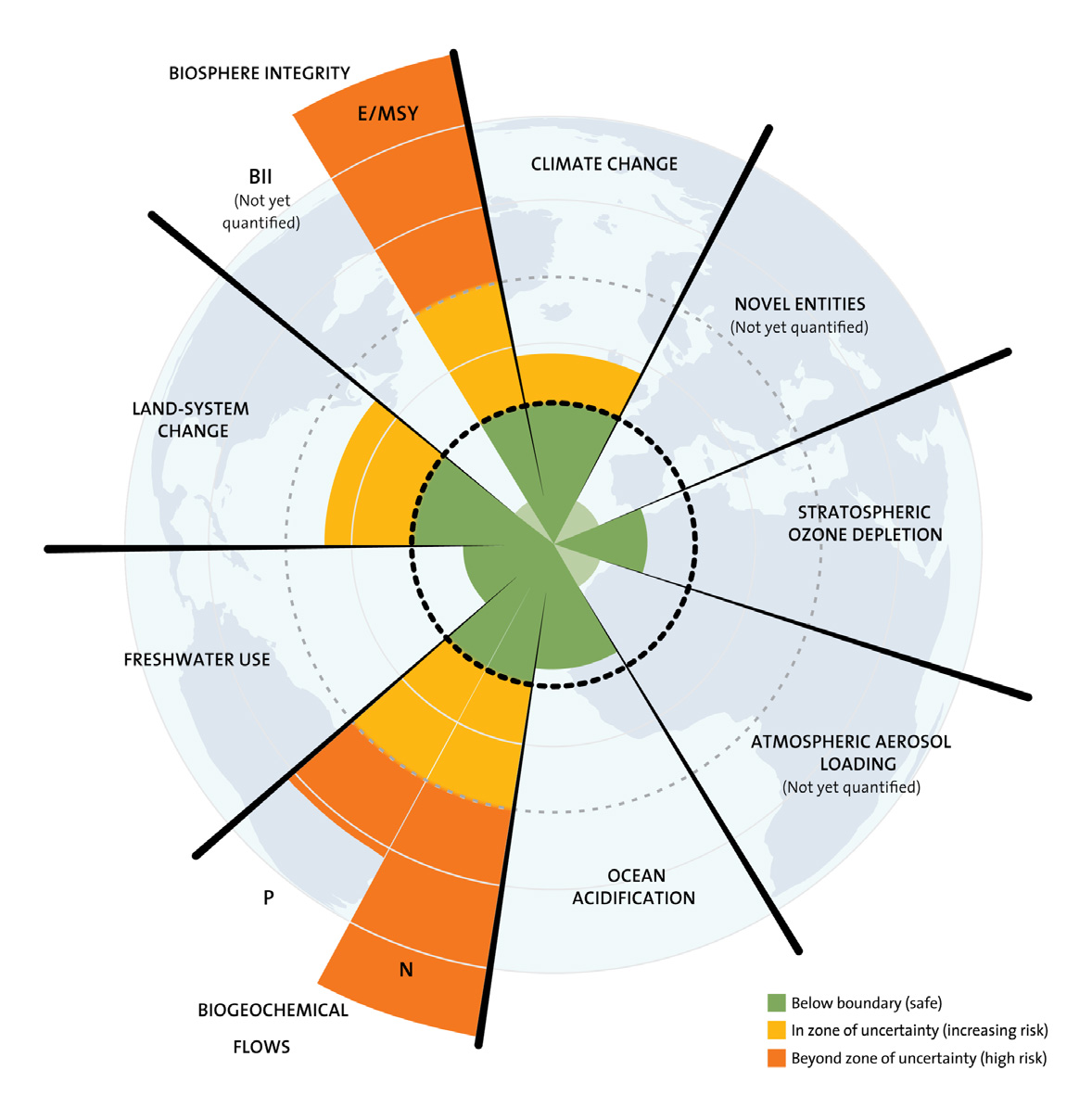10/01/2022
Pathways to sustainable innovations
Throughout the industrial history of mankind, we have created new innovations based on the techno-economic point of view or paradigm. In the early seventies, Club of Rome published a report called The Limits to Growth. Since then, it has been common knowledge in our societies and among industry and world leaders, that we have to find more sustainable ways of developing industrial innovations to guarantee a comfortable life for humans and other lifeforms on this planet, which as far as we know, is the only one able to support the kind of life we live today.
In this article, we describe some pathways to sustainable innovations and provide background for sustainable thinking in general.
The planetary boundaries of industrialization
The techno-economic paradigm has been one of the key drivers of industrial revolution which has been at the center of mankind’s actions for approximately 200 years. The model known as Kondratiev waves connects key industrial innovations and economic cycles together. These innovations have propelled economic wealth throughout the industrialized centuries.
The purpose of the Kondratiev wave model is not to depict environmental impacts. It was developed to represent the economic sustainability of western economies. It is worth taking into consideration, that most of the best industrial innovations remain in use for long periods of time once they have been adopted on a large scale (e.g., combustion engine, coal-based electricity, natural gas-based fertilizers etc.) However, looking at the wave model today and connecting the environmental impact information of key industrial technologies, we can see that the environment has paid a price for our development.

Later studies, that have connected human technological impacts to earth’s lifeforms and the systems that support them, have created the planetary boundaries model. Studies into the planetary boundaries model, such as those conducted at Stockholm University’s Resilience Center, show that human industrial actions are key reasons for environmental problems.
In light of this, it is clear that we should aim to make new innovations sustainable or at least more sustainable in relation to the planetary boundaries, and this should be the guiding principle of strategic thinking.

Sustainable revolution
What is sustainability”? Wikipedia defines it as follows: “Sustainability is the capacity to endure in a relatively ongoing way across various domains of life. In the 21st century, it refers generally to the capacity for Earth’s biosphere and human civilization to co-exist. Sustainability has also been described as “meeting the needs of the present generation without compromising the ability of future generations to meet their needs” (Brundtland, 1987). For many, sustainability is defined through the interconnected domains of environment, economy and society. Sustainable development, for example, is often discussed through the domains of culture, tehnology, economics and politics.”
The definition of sustainability through the interconnected domains of the environment, economy and society is sometimes taken to mean that these three are of equal importance. In this article, we question this. The problem here is the same as with the techno-economic paradigm. It seems to decrease role of the environment or place it in a minor role in our decisions, while in reality its role is substantially bigger than that of the other two. We believe that the next wave of change, after the industrial revolution, will be a sustainable revolution.
Pathways to sustainability
When setting strategic targets to new innovations we have concluded that innovations have to be sustainable from the point of view of the environment now or in the near future, and this has to be a key target in development in accordance with, for example, the Paris agreement.
Currently, when it comes to sustainability, most companies choose to take no actions and make no changes in product design, even if sustainable materials are available. This is due to higher costs or other strategic reasons within the business. We believe that this is short-sighted.
As innovators, we used a method of brainstorming solutions based on simple phases or principles. Based on the idea that sustainability is the key driver of technology and product development, we created the following pathways towards sustainability:
- Pathway 1/10. Wait for sustainable materials or create them. Wait until material, part and component suppliers have sustainable materials available and start using them. Or start developing them yourself.
- Pathway 2/10. Aim for a more sustainable product. Start actions immediately and do everything possible right now. Use more sustainable materials, even if fully sustainable materials are not yet available, adapt product design to accommodate more sustainable materials.
- Pathway 3/10. Aim for a fully sustainable product. Start developing a fully sustainable product, even if it leads to radical changes in product structure, performance etc.
- Pathway 4/10. Look at the bigger picture. Accept unsustainable products in cases where the product helps to decrease the total emissions of some bigger system it is a part of.
- Pathway 5/10. Discontinue unsustainable products. Stop producing unsustainable products.
- Pathway 6/10. Favor handcrafting. Return to old technology, which often automatically leads to more sustainable production, for example, using manual powered tools instead of fossil fuel powered machines etc.
- Pathway 7/10. Reduce and recycle. Use only recycled or side stream materials and reuse aborted components
- Pathway 8/10. Produce more durable products. Extend product lifetime to transgenerational.
- Pathway 9/10. Control your emissions. Minimize emissions and compensate for any remaining emissions.
- Pathway 10/10. Aim for a more than sustainable product. Create a more than sustainable, carbon negative product, a carbon sink. Is this principle applicable to other emission types than carbon?
Even at first glance, some of these pathways are clearly more sustainable than others. We chose a few of them for closer inspection based on which ones might prove most fruitful.
We looked at the pathways from the point of view of future generations in world where sustainable development is already underway and tried to introduce some ways these pathways might be used as design principles.
Use of windmill blades (Pathway 7)
Thousands of used windmill blades are piling up in landfills annually, and no proper way for recycling them has been created so far. It is not difficult to see that those blades could easily be converted into wing sails. Use as a sail is less demanding for the blades, so they could still have a long service life ahead and produce vast amounts of renewable energy, replacing the use of fossil fuel. This type of wing sails could be used as auxiliary propulsion devices in various ships (tens of thousands of compatible ones exist) right away, compensating partially for the use of fossil fuel. Countless piles of old windmill blades exist out there. There is no reason why this couldn’t be done today.
Accepting unsustainability (Pathway 4)
This should be taken to mean that partial unsustainability is accepted, or unsustainability is allowed for a limited period of time. The principle is described in Buckminster Fuller’s Operation Manual for Spaceship Earth (1969). Fuller wrote that daily consumption should be based on renewables, and fossil fuel should be reserved for the exclusive function of getting new life supporting machinery built. One interpretation of Fuller’s ideas is, that he understood that the constant use of fossil fuel and non-renewable materials connected to pollution will inevitably lead to an ecological bankruptcy.
Creating the ideal product based on sustainable goals (Pathway 3)
According to the concept of ideality, an ideal [technical] system is one, where the function of the system gets fulfilled without the system itself. For example, holographic stickers are used as an antitheft device on product packages. Such a sticker consists of multiple polymer and metal materials and needs a specific machine for applying it on the package. The very same function can be fulfilled by embossing an optical grating directly on the package material itself. No material whatsoever is added to the system, and still the function is performed, actually better than by using stickers.
The meaning of paths
As you see, these principles have been combined in many ways and not used in their pure form. Or even explained only in theory. Is there a reason why these principles are rarely used? We have seen that complexity, and complex technical devices, is a product of the industrial revolution and one of the key elements that should be changed. Simple solutions may lay in the far history of the industrial age when complexity was not easily achieved and unfunctional products were rarely created. It may have to be accepted that some modern standards have to be decreased or replaced completely to get on a sustainable path.
Our solution to get human technologies to a sustainable path is quite simple. We have to keep increasing the level of sustainability of our products and technologies until they are fully sustainable. First from the point of view of the environment, and later on a wider scale taking into consideration the environment, society and economy.
Design for circular economy a solution for increased sustainability? (Pathway 1)
Päivi Kivikytö-Reponen & Marjaana Karhu, VTT
Keeping materials in use, retaining their value as high as possible, and avoiding material degradation and waste, are the key strategies of circular economy. However, currently, the average lifetime of many devices is relatively low, as the rapid technological development of devices leads to outdated solutions in a few years’ time. Still, e.g., the use of digital applications and digital devices continues to grow due to increasing amounts of content in digital format.
Furthermore, many materials used for digitalization and the required devices are challenging, such as critical, conflict and hazardous materials. Due to overcoming these challenges of electrical and electronics sector, the importance of design for circular economy is currently acknowledged. For example, from a sustainability perspective, the design phase may determine as much as 80% of the environmental impact of a product. (European Commission, 2014). Typically, circular design strategies cover ’narrowing’, ‘slowing’ and ‘closing’ the material loops. These are the strategies that can be the bases of business models in material, product and service design.
First of all, the materials should fit to circular systems, and therefore, it is essential to take into consideration and understand the whole lifecycle of the materials. It is sometimes forgotten that circular systems require both circular materials and circular products, therefore both circular material design and circular product design are important steps. However, there seems to be more literature about circular product design than circular material design concepts. The key product design concepts and terms of the ‘design for circular economy’ of have been reviewed by Hollander et al. (Hollander 2017) stating circular product design encompasses both design for product integrity and design for recycling. Product integrity covers longer lifetime strategies such as design for emotinal and physical durability, design for maintenance and upgrading and design for repair, design for refurbishment and design for remanufacturing (Hollander 2017).
We all have a role in sustainable development
In this article, we have introduced ways and methods that lead to the path of sustainable development. The keys to the future are in our hands when we are making decisions about future products and technologies.
Sustainability will be integrated into every decision that we make in the future, and you can start with small details or with deeper strategic thinking depending on your role.
Decisions that let nature recover and recapture human based carbon emissions and traces of human land use might even be free and happen without human involvement in some areas if we allow it. In other places, human intervention is needed in order to facilitate regeneration.
The wildest dreams of technological solutions to tackle climate change and revolutionize our daily life, such as inhabiting Mars, are interesting and exciting. But they beg the question whether they will be available readily enough to make a difference and tackle problems on a wider scale. Maybe the better solution would be to create pathway solutions that improve products and technologies and take us one step closer to achieving sustainability.
While many new technologies genuinely do work to create a cleaner, more sustainable future, we cannot let ourselves be so intoxicated with our unwavering believe in technology, that we close our eyes to the fact that more sustainable choices must be made now. What could you do to make your product more sustainable? And what’s stopping you?


